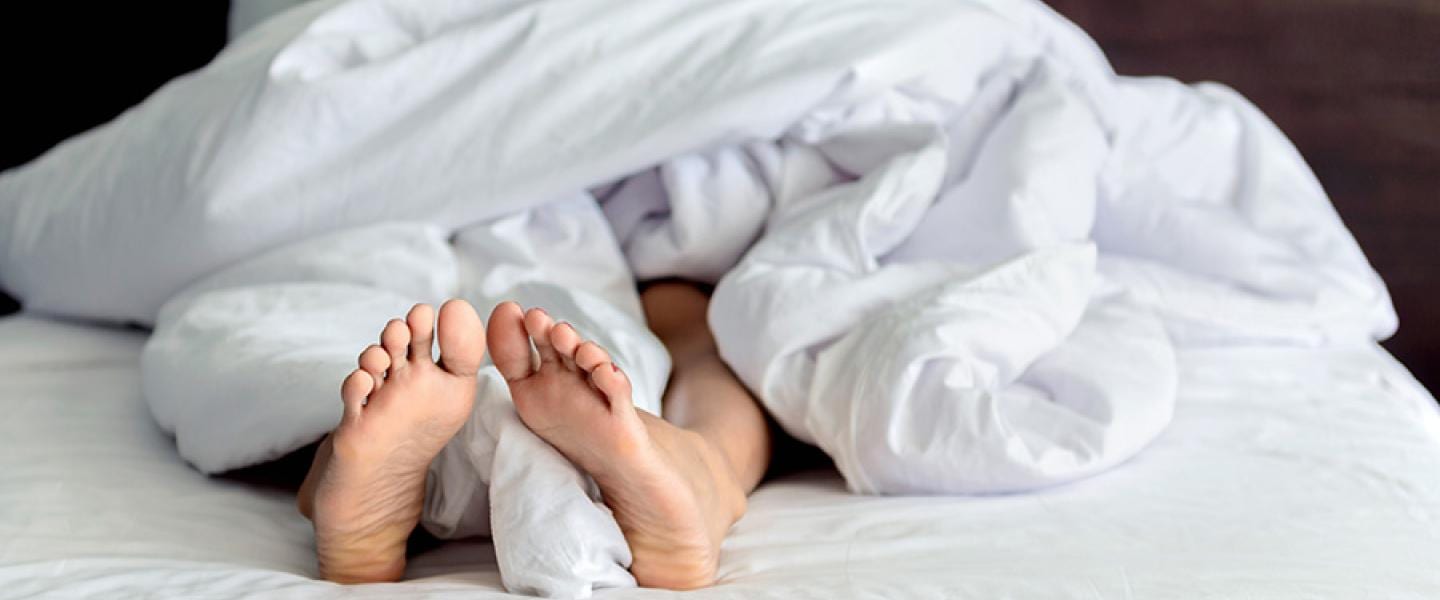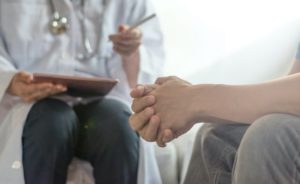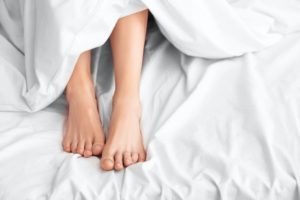Home Remedies for Restless Legs Syndrome
- Home remedies for restless legs syndrome, including regular exercise, stress management, stretching, warm baths, and massage, can work alongside medical treatments to improve symptoms.
- Your doctor can also help you learn and avoid your RLS triggers (caffeine, stress, alcohol, nicotine, and certain medications), and may offer an iron supplement if your levels are low.
The uncomfortable urge to move your legs at night can make falling asleep feel impossible. Restless legs syndrome (RLS), a sleep-related movement disorder, affects up to 15% of people in the United States and causes an uncontrollable urge to move the legs to relieve feelings people describe as deep crawling, pulling, or tingling .
While there’s no cure, self-care techniques can work alongside other RLS treatments to help ease these uncomfortable sensations. From taking warm baths to stretching before bedtime, small changes at home may make a big difference in how well you sleep.
Take Care of Your Legs and Feet
Restless legs syndrome self-care near bedtime can help lessen leg discomfort, which may then help improve your sleep. Some of the ways you can take care of your legs and feet before bed include:
- Massaging your legs and feet
- Stretching your legs (see below for specific stretches)
- Taking a warm or cool bath
- Relaxing in a whirlpool tub
- Resting your legs on a heating pad
- Applying a cold compress or ice pack to your legs
Reduce and Manage Stress
RLS symptoms can get worse with mounting stress and anxiety, but prioritizing your mental well-being can help keep them at bay. For less stress, try:
- Yoga and stretching
- Meditation and deep breathing
- Journaling and practicing gratitude
- Spending time outdoors
- Connecting with friends and family
- Getting enough sleep
- Exercising for 20 to 30 minutes a day
- Eating a nutritious diet
- Avoiding nicotine and alcohol
Taking time away from news and social media can also relieve stress, so try to build in some screen-free time as part of your nightly routine.
Exercise Regularly
Regular exercise can reduce RLS symptoms, help you sleep better, and manage stress. If you can, work up to a goal of 150 to 300 minutes per week of moderate-intensity exercise, like:
- Taking a brisk walk
- Raking leaves in the yard
- Water aerobics
- Swimming
- Cycling
- Doubles tennis
- Pushing a lawn mower
You’ll see the best effects if you exercise moderately and consistently, and non-vigorous activities like yoga and walking can be just as beneficial .
Stretch Before Bed
Relief with movement is a hallmark sign of restless legs syndrome, so it makes sense that stretching could set you up for fewer symptoms and better sleep . Stretching can also improve your flexibility and prevent injury while exercising — another important component for RLS self-care. A few recommended leg stretches include:
- Calf stretch: Starting with your feet together, step forward with one foot, keeping the heel of the back foot on the floor. Bend the knee of your front leg and lean forward until you feel a pull in the calf of your back leg. Hold for 10 to 30 seconds, then release and repeat on the opposite side.
- Hamstring stretch: Sitting on the floor, extend one leg out in front of you, then lean forward until you feel the stretch in the back of the thigh. Hold for 10 to 30 seconds, then repeat with your other leg.
- Quadriceps stretch: Stand with your legs together and place a hand on a nearby wall or sturdy piece of furniture. Grasp one ankle and gently pull your foot up and back toward your buttock. Hold for 10 to 30 seconds, then repeat on the other side.
Avoid Triggers
Some substances and medications can trigger symptoms of RLS, so it can be helpful to avoid these:
- Caffeine: Caffeine is a stimulant found in coffee, tea, soft drinks, energy drinks, chocolates, and some over-the-counter medications.
- Alcohol: Some providers recommend avoiding alcohol, especially in the evening, for a trial period to see if symptoms improve .
- Nicotine: Nicotine is a chemical from the tobacco plant and is found in cigarettes, cigars, e-cigarettes, and smokeless tobacco.
- Some medications: Medications like selective serotonin reuptake inhibitors (SSRIs), serotonin-norepinepherine reuptake inhibitors (SNRIs), diphenhydramine, and some psychiatric medications can worsen RLS symptoms.

Take a Warm Bath
When you provide other sensory stimulation to your legs, like heat from a warm bath, you can lessen the unpleasant feelings that come with RLS . Several studies have shown improved symptoms from taking warm baths, and this method offers a relaxing way to wind down before bed while also increasing your chances of fewer leg movements and better sleep.
“Epsom salt sitz baths can be particularly beneficial, as the magnesium in epsom salts reduces pain, swelling and muscle tension,” says sleep medicine physician Lulu Guo, MD.
To get the most benefit out of a warm bath, you can include some other self-care activities during that time, like gentle stretches and deep breathing.
Use a Heating Pad or Ice Pack
Like with a bath, using a heating pad or ice pack for RLS symptoms can add new stimulation to the legs and ease uncomfortable sensations. For restless legs syndrome, apply a heating pad or ice pack to your legs before bed for no more than 20 minutes .
Take care not to let your warm pack or heating pad get too hot. You can wrap either in towels to protect your skin from burns. Similarly, make sure to wrap your cold pack — don’t place it directly on the skin.
Massage Your Legs
Massaging your legs can provide stimulation and mimic the movement that relieves RLS symptoms, and many people with restless legs syndrome notice improvement with massage.
While massage offers plenty of benefits, it’s important to be aware of the risk of blood clots when massaging your legs. If one leg is swollen and tender, hold off on the leg massage until you can get it checked out by a doctor .
Distract Yourself
Distraction can improve pain, and research suggests it may also lessen symptoms of restless legs syndrome . You can distract yourself any way you choose, but here are some ideas:
- Do a puzzle
- Read a book
- Play a game
- Listen to music
- Count backward
- Color or draw
Consider an Iron Supplement
Low levels of iron in the blood is one common cause of restless legs syndrome, and increasing those levels can improve symptoms . If you know your iron levels are low, you can ask your doctor about an oral iron supplement to take daily at home . The general goal for iron levels is to be on the high side of normal to help with restless legs.
For some with very low iron levels, IV iron therapy may be needed, especially if they experience severe symptoms of RLS.
Practice Good Sleep Hygiene
Most people with restless legs syndrome have insomnia, but following healthy sleep hygiene practices can help you get better sleep with RLS . Adults 18 and older need seven to eight hours of sleep per night, and those who don’t get enough sleep often notice worse RLS symptoms.
Good sleep hygiene includes habits like:
- Keeping your bedroom environment dark and quiet
- Putting electronic devices away and not watching TV or looking at any screens before bedtime
- Avoiding alcoholic beverages or tobacco products before bedtime
- Cutting out caffeine-containing foods and beverages after lunchtime
- Going to sleep and waking up at the same time every day
- Limiting naps to no more than one hour and not napping in the late afternoon
- Stopping exercise between four and six hours before bedtime
- Getting out of the bed to a different area if unable to fall asleep for more than 40 minutes
Frequently Asked Questions
What is the best over-the-counter medicine for restless leg syndrome?
No over-the-counter medications are recommended for the treatment of restless leg syndrome. But some small studies claim vitamin D and magnesium supplements can help lessen symptoms. Be sure to check with your doctor before starting any new supplement.
Will drinking more water help restless legs?
No research shows that drinking more water helps restless leg syndrome symptoms, but staying hydrated can improve muscle cramps .
Will pickle juice help with restless legs?
No studies prove that pickle juice helps with restless legs, but one small study found it may lessen leg cramp severity .
Do bananas stop restless legs?
Bananas have a small amount of magnesium, which some research suggests may improve RLS symptoms. But bananas alone may not offer enough magnesium to make a difference .
References
25 Sources
-
Ondo, W. (2022, May 18). Clinical features and diagnosis of restless legs syndrome and periodic limb movement disorder in adults. In H.I. Hurtig & A.Y. Avidan (Eds.). UpToDate.
https://www.uptodate.com/contents/clinical-features-and-diagnosis-of-restless-legs-syndrome-and-periodic-limb-movement-disorder-in-adults -
Bozorg, A. M. (2022, January 6). Restless legs syndrome. Medscape.
https://emedicine.medscape.com/article/1188327-overview#showall -
MedlinePlus: National Library of Medicine (US). (2018, May 1). Restless legs syndrome.
https://medlineplus.gov/genetics/condition/restless-legs-syndrome/ -
CDC. Managing Stress. Mental Health. Published June 9, 2025.
https://www.cdc.gov/mental-health/living-with/index.html -
U.S. Department of Health and Human Services. (n.d.). Physical activity guidelines for Americans (2nd edition).
https://health.gov/sites/default/files/2019-09/Physical_Activity_Guidelines_2nd_edition.pdf -
CDC. What Counts as Physical Activity for Adults. Physical Activity Basics. Published December 6, 2023.
https://www.cdc.gov/physical-activity-basics/adding-adults/what-counts.html -
National Institute of Neurological Disorders and Stroke. (2023, February 7). Restless legs syndrome.
https://www.ninds.nih.gov/health-information/disorders/restless-legs-syndrome -
Schwab, R. J. (2024, June). Periodic Limb Movement Disorder (PLMD) and Restless Legs Syndrome (RLS). Merck Manual Professional Version.
https://www.merckmanuals.com/professional/neurologic-disorders/sleep-and-wakefulness-disorders/periodic-limb-movement-disorder-plmd-and-restless-legs-syndrome-rls -
Gossard, T. R., Trotti, L. M., Videnovic, A., & St Louis, E. K. (2021). Restless Legs Syndrome: Contemporary Diagnosis and Treatment. Neurotherapeutics : the journal of the American Society for Experimental NeuroTherapeutics, 18(1), 140–155.
https://pubmed.ncbi.nlm.nih.gov/33880737/ -
Peterson, Douglas M., M.D. (2024, November 19). Patient education: Exercise (Beyond the Basics). UpToDate.
https://www.uptodate.com/contents/exercise-beyond-the-basics -
Silber, M. H. (2024, June 14). Management of restless legs syndrome and periodic limb movement disorder in adults. UpToDate.
https://www.uptodate.com/contents/management-of-restless-legs-syndrome-and-periodic-limb-movement-disorder-in-adults -
Rozeman, A. D., Ottolini, T., Grootendorst, D. C., Vogels, O. J., & Rijsman, R. M. (2014). Effect of sensory stimuli on restless legs syndrome: a randomized crossover study. Journal of clinical sleep medicine : JCSM : official publication of the American Academy of Sleep Medicine, 10(8), 893–896.
https://pubmed.ncbi.nlm.nih.gov/25126036/ -
Isaac, Zacharia, M.D., (2023, November). Rehabilitative Measures for Treatment of Pain and Inflammation. Merck Manual Consumer Version.
https://www.merckmanuals.com/professional/special-subjects/rehabilitation/rehabilitative-measures-for-treatment-of-pain-and-inflammation -
Douketis JD. Deep Venous Thrombosis (DVT) – Cardiovascular Disorders. Merck Manuals Professional Edition. Published September 2022.
https://www.merckmanuals.com/professional/cardiovascular-disorders/peripheral-venous-disorders/deep-venous-thrombosis-dvt -
NCCIH. Massage Therapy: What You Need to Know. NCCIH. Published May 2019.
https://www.nccih.nih.gov/health/massage-therapy-what-you-need-to-know -
Rischer KM, González-Roldán AM, Montoya P, Gigl S, Anton F, van der Meulen M. Distraction from pain: The role of selective attention and pain catastrophizing. Eur J Pain. 2020;24(10):1880-1891. doi:10.1002/ejp.1634
https://pubmed.ncbi.nlm.nih.gov/32677265/ -
Silber, M. H., Buchfuhrer, M. J., Earley, C. J., Koo, B. B., Manconi, M., Winkelman, J. W., & Scientific and Medical Advisory Board of the Restless Legs Syndrome Foundation. (2021). The management of restless legs syndrome: An updated algorithm. Mayo Clinic Proceedings, 96(7), 1921–1937.
https://pubmed.ncbi.nlm.nih.gov/34218864/ -
Winkelman, JW, Berkowski, JA, DelRosso, et al. Treatment of restless legs syndrome and periodic limb movement disorder: an American Academy of Sleep Medicine clinical practice guideline. J Clin Sleep Med. 2025;21(1):137–152
https://jcsm.aasm.org/doi/10.5664/jcsm.11390 -
Winkelman, J. (2024, March). Overview of the treatment of insomnia in adults. In R. Benca & A. Eichler (Ed.). UpToDate.
https://www.uptodate.com/contents/overview-of-the-treatment-of-insomnia-in-adults -
González-Parejo, P., Martín-Núñez, J., Cabrera-Martos, I., & Valenza, M. C. (2024). Effects of Dietary Supplementation in Patients with Restless Legs Syndrome: A Systematic Review. Nutrients, 16(14), 2315.
https://pubmed.ncbi.nlm.nih.gov/39064758/ -
Gorantla, S., Ravisankar, A., & Trotti, L. M. (2024). Magnesium citrate monotherapy improves restless legs syndrome symptoms and multiple suggested immobilization test scores in an open-label pilot study. Journal of clinical sleep medicine : JCSM : official publication of the American Academy of Sleep Medicine, 20(8), 1357–1361.
https://pubmed.ncbi.nlm.nih.gov/38738598/ -
Marshall, N. S., Serinel, Y., Killick, R., Child, J. M., Raisin, I., Berry, C. M., Lallukka, T., Wassing, R., Lee, R. W., Ratnavadivel, R., Vedam, H., Grunstein, R., Wong, K. K., Hoyos, C. M., Cayanan, E. A., Comas, M., Chapman, J. L., & Yee, B. J. (2019). Magnesium supplementation for the treatment of restless legs syndrome and periodic limb movement disorder: A systematic review. Sleep Medicine Reviews, 48, 101218.
https://pubmed.ncbi.nlm.nih.gov/31678660/ -
MedlinePlus: National Library of Medicine (US). (2020, August 13). Muscle cramps. Retrieved August 10, 2022, from
https://medlineplus.gov/musclecramps.html -
Pulous VE, Jackson CD, Wheeler SGB. EBM BLS: Pickle Juice Decreases Muscle Cramp Severity in Patients with Cirrhosis. J Gen Intern Med. 2023;38(11):2636-2637. doi:10.1007/s11606-023-08224-1
https://pubmed.ncbi.nlm.nih.gov/37296359/ -
National Institutes of Health Office of Dietary Supplements. (2022, June 2). Magnesium: Fact sheet for health professionals.
https://ods.od.nih.gov/factsheets/Magnesium-HealthProfessional/




